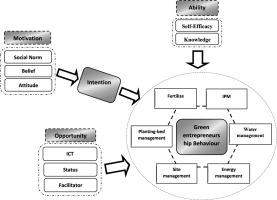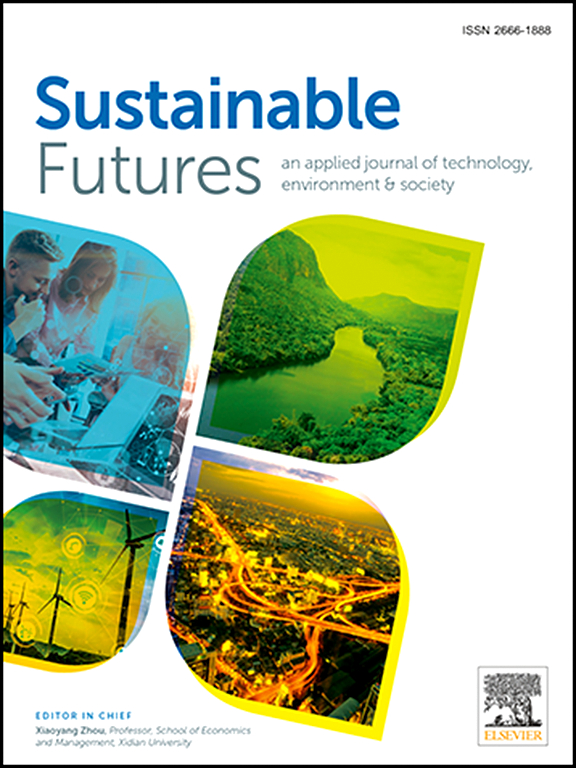动机-机会-能力模型在农民绿色创业行为预测中的应用
IF 4.9
2区 社会学
Q2 ENVIRONMENTAL SCIENCES
引用次数: 0
摘要
与气候变化、资源过度消耗、生物多样性丧失和可持续性问题相关的不断升级的环境挑战在很大程度上是人为造成的,受到企业主做法的重大影响。要应对这些挑战,就必须转变行为,转向绿色创业,以此作为通往可持续未来和环境保护的途径。本研究采用动机-机会-能力(MOA)模型,对伊朗北部戈列斯坦省温室经营者的绿色创业行为(GEB)进行建模,重点关注社会心理结构。这项研究包括对该地区70个蔬菜温室单位的全面调查。利用Smart PLS3软件,通过偏最小二乘(PLS)方法建立结构方程模型,对数据进行分析。结果表明,意向对行为的影响最大(路径系数为0.410,t值为4.369),其次是能力和机会。绿色创业意向(GEI)、机会和能力的潜在变量共同解释了大约75%的GEB方差。此外,社会规范、信仰和态度的结构占GEI方差的76.4%。这些研究结果证实了MOA模型在绿色创业中发挥的深刻作用,并为规划者和决策者提供了战略建议,通过改善生产系统的内部和外部结构,强调心理、社会、经济和环境因素在实现可持续发展和粮食安全中的互补关系,建立绿色创业。本文章由计算机程序翻译,如有差异,请以英文原文为准。

The application of the motivation-opportunity-ability model in predicting green entrepreneurial behavior of farmers
The escalating environmental challenges linked to climate change, excessive resource consumption, biodiversity loss, and sustainability issues are largely human-driven, influenced significantly by the practices of business owners. Addressing these challenges necessitates behavioral shifts towards green entrepreneurship as a pathway to a sustainable future and environmental protection. This study models green entrepreneurial behavior (GEB) among greenhouse operators in Golestan Province, northern Iran, employing the Motivation-Opportunity-Ability (MOA) model, with a focus on socio-psychological structures. The research involved a complete survey of 70 vegetable greenhouse units in the region. Data analysis was conducted using structural equation modeling through the Partial Least Squares (PLS) method with Smart PLS3 software. Results revealed that the intention to adopt GEB had the strongest effect on behavior (path coefficient = 0.410, T-value = 4.369), followed by the ability and opportunity components. The latent variables of green entrepreneurial intention (GEI), opportunities, and abilities collectively explained approximately 75 % of the variance in GEB. Furthermore, the constructs of social norms, beliefs, and attitudes accounted for 76.4 % of the variance in GEI. These findings confirm the profound role of the MOA model in the adoption of green entrepreneurship and provide strategic recommendations for planners and policymakers to establish green entrepreneurship by improving the internal and external structure of the production system, emphasizing the complementary relationships between psychological, social, economic, and environmental factors in achieving sustainable development and food security.
求助全文
通过发布文献求助,成功后即可免费获取论文全文。
去求助
来源期刊

Sustainable Futures
Social Sciences-Sociology and Political Science
CiteScore
9.30
自引率
1.80%
发文量
34
审稿时长
71 days
期刊介绍:
Sustainable Futures: is a journal focused on the intersection of sustainability, environment and technology from various disciplines in social sciences, and their larger implications for corporation, government, education institutions, regions and society both at present and in the future. It provides an advanced platform for studies related to sustainability and sustainable development in society, economics, environment, and culture. The scope of the journal is broad and encourages interdisciplinary research, as well as welcoming theoretical and practical research from all methodological approaches.
 求助内容:
求助内容: 应助结果提醒方式:
应助结果提醒方式:


